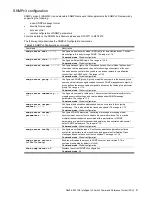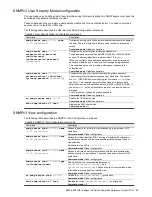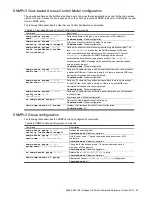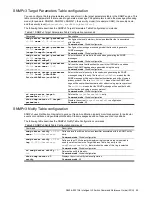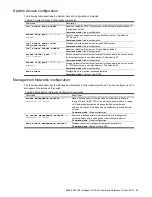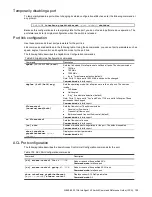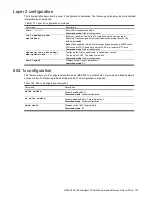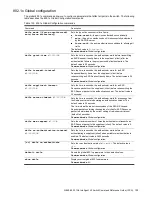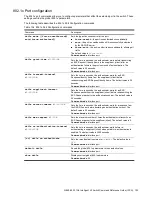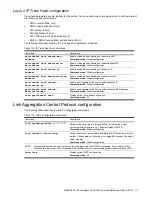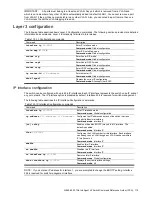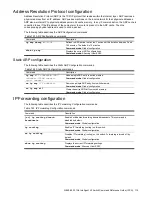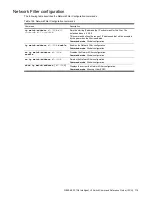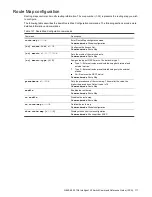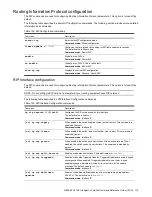
N8406-023 1Gb Intelligent L3 Switch Command Reference Guide (ISCLI) 104
Rapid Spanning Tree Protocol / Multiple Spanning Tree Protocol
configuration
The switch supports the IEEE 802.1w Rapid Spanning Tree Protocol (RSTP) and IEEE 802.1s Multiple Spanning
Tree Protocol (MSTP). MSTP allows you to map many VLANs to a small number of spanning tree groups, each
with its own topology.
You can configure up to 32 spanning tree groups on the switch.
NOTE: When Multiple Spanning Tree is turned on, VLAN 1 is moved from Spanning Tree Group 1 to the
Common Internal Spanning Tree (CIST). When Multiple Spanning Tree is turned off, VLAN 1 is moved back to
Spanning Tree Group 1.
The following table describes the Multiple Spanning Tree Configuration commands.
Table 105 Multiple Spanning Tree Configuration commands
Command
Description
[no] spanning-tree mstp
name
<
1-32 characters
>
Configures a name for the MSTP region. All devices within a MSTP region
must have the same region name.
Command mode
: Global configuration
spanning-tree mstp
version
<
0-65535
>
Configures the revision level for the MSTP region. The revision level is used as
a numerical identifier for the region. All devices within a MSTP region must
have the same revision level number. The range is 0-65535. The default value
is 1.
Command mode
: Global configuration
spanning-tree mstp
maximum-hop
<4-60>
Configures the maximum number of bridge hops a packet may to traverse
before it is dropped. The range is from 4 to 60 hops. The default is 20.
Command mode
: Global configuration
spanning-tree mode
{mst|rstp|pvst}
Selects either Rapid Spanning Tree mode, as follows:
Rapid Spanning Tree mode (rstp)
Multiple Spanning Tree mode (mstp).
Per VLAN Spanning Tree (pvst)
The default mode is pvst.
Command mode
: Global configuration
show spanning-tree mstp
mrst
Displays the current RSTP/MSTP configuration.
Command mode
: All
NOTE:
IEEE 802.1w standard-based RSTP implementation runs on one STG (i.e. same as one spanning tree
instance) only. As a result, if ‗rstp‘ mode is selected, then only a single RSTP instance (default for STG 1)
is supported for all VLANs, including the Default VLAN 1.
If multiple spanning tree instances are required, then select ‗mstp‘ mode so that multiple VLANs are
handled by multiple spanning tree instances, as specified by IEEE 802.1s standard-based MSTP
implementation.
IEEE 802.1s MSTP supports rapid convergence using IEEE 802.1w RSTP.
PVST+ does not support rapid convergence in current versions.
NOTE:
The following configurations are unsupported:
PVST+ (default Spanning Tree setting) is NOT interoperable with Cisco Rapid PVST+.
MSTP/RSTP (with mode set to either ‗mstp‘ or ‗rstp‘) is NOT interoperable with Cisco Rapid PVST+.
The following configurations are supported:
PVST+ (default Spanning Tree setting) is interoperable with Cisco PVST+.
MSTP/RSTP (with mode set to ‗mstp‘) is interoperable with Cisco MST/RSTP.


